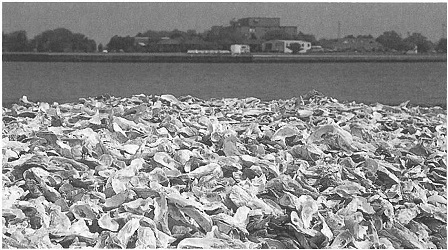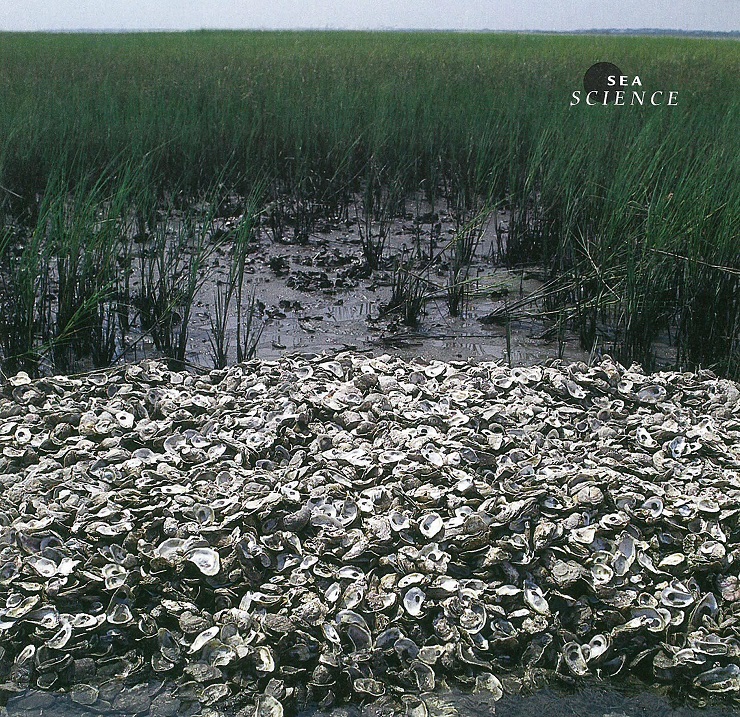A good investment means getting more out of a project than was put in. That’s not rocket science. It’s not oyster science either, according to Jonathon Grabowski, doctoral candidate in marine ecology at UNC Institute of Marine Sciences, Morehead City.
The state invests around $700,000 each year restoring ever-diminishing oyster reefs. But the total annual oyster harvest is not much more than that — about $800,000 to $900,000 — and most does not come from restored reefs, according to Mike Marshall, fisheries biologist for the N.C. Division of Marine Fisheries (DMF). The math can make oyster reef restoration appear less than profitable.
But Grabowski had a hunch that investments in oyster reef restoration pay back more than is readily apparent on a balance sheet. With funding from the N.C. Fishery Resource Grant Program (FRG), he got a chance to test his oyster market theory.
It starts with the common American or eastern oyster — Crassostrea virginica to scientists. A study in craggy gray asymmetry, it’s not what could be called pretty. It’s not picky, either. Oysters stick to almost any solid surface in the estuary — along shorelines, clinging to pilings or glued to almost any accumulated detritus. Throw in a concrete block; grow a small oyster garden.

Oysters can withstand days of inhospitable conditions just by clamming up. They tolerate a wide range of temperatures, salinity and oxygen levels. En masse, they form fortresses of razor edges standing at attention.
Yet, despite its resilience and penchant for proliferation, the oyster is in trouble. The nearly 2 million bushel harvest in North Carolina at the turn of the 20th century had dropped to about 300,000 bushels by the 1920s and I 930s.
And the state’s oyster harvests continue to decrease each year — from 95,000 pounds in 1997 to 54,000 in 1998 and 39,000 in 1999.
“It is reported that (oyster reefs) were so extensive they were obstacles to navigation” in the Neuse River, Grabowski adds. Today, oyster rocks are hardly grand enough to be thought of as reefs.
Reefs are formed when millions of tiny oyster larvae are released from parent oysters and drift to suitable solid surfaces where they attach and grow. They have a particular affinity for the shells of other oysters. Under the right circumstances, the result is generation upon generation forming huge aggregations that, like the more photogenic coral reefs, can support a busy array of other life forms.
It may not be our appetite for oysters so much as our means for appeasing it that began the downfall of the grand oyster reefs. The use of mechanical dredges for harvesting oysters around the turn of the century probably caused the earliest and most profound losses, Grabowski says. Dredges “hammered oyster reefs,” he says, “and removed the foundation upon which oysters had settled previously.”
Paradoxically, one reason for the continuing decline, is water quality deterioration — a problem oyster reefs could potentially help to alleviate.
Most scientists believe bivalves such as oysters contribute to good water quality because of their filtering ability, Marshall says. There are no quantitative data on the benefit to the estuary, he adds. But if oysters help purify water, then the larger the reef, the more significant the benefit is likely to be.
In addition to effects on water quality, oyster reefs help stabilize salt marshes, “providing refuge, food and nursery grounds to a diverse assemblage of animals,” Grabowski reports.
But restoring oyster reefs is a little like replanting a rain forest. It’s difficult to rebuild an ecosystem, especially if the conditions under which the original system developed have changed or no longer exist.
“It can be difficult for extremely impaired systems to recover on their own — restoration may be the only viable option for returning the integrity of these impaired systems,” Grabowski says.
“Often ecologists talk about ‘stable states’ in the applied sciences,” Grabowski says. It’s difficult to shift the system back once it’s been damaged, he explains. In the case of oyster reef restoration, his FRG-funded study shows it’s worth the effort.
OYSTER REEF RESTORATION
The preferred substrate for reef restoration is oyster shell, most of which comes from the shucking industry, Marshall says. Shells from other bivalve mollusks, like clams or scallops, also can be used. Another alternative is marl — fossilized sedimentary rock that contains a substantial amount of calcium carbonate, a main ingredient in oyster shells.
Marshall describes two methods used to rebuild oyster reefs. In shallow, tidal estuaries in the southern coastal region where the moon affects tides, reef material is sprayed off the decks of boats into areas marked off with pilings.
In deeper, subtidal estuaries of the northern areas where tides are wind-driven, the material is dumped into piles with a front-end loader into areas marked off by buoys.
Since the water is deeper, the reef materials can be mounded to taller elevations providing a habitat above areas that suffer from low dissolved-oxygen levels.
Grabowski’s study — along with those of Charles “Pete” Peterson and Hunter Lenihan of UNC-CH — is providing important data, according to Marshall, and can help determine the best sites for restoring reefs.
BUILDING REEFS
Grabowski restored reefs in Middle Marsh, Carteret County, in three types of areas where oyster reefs tend to form naturally. These areas, or landscapes, are edges of salt marshes isolated from sea grass habitat, areas between salt marshes and sea grass beds, and mudflats away from vegetation.

Shells and the use of shallow-draft barges for Grabowski’s study were provided by DMF, with Marshall and Jeff French, also of the division, collaborating. “Though oyster reefs have only recently received recognition as a habitat to protect rather than a single-species resource to exploit, DMF has remained committed to assisting reef research and has been instrumental to the successful design and completion of several important restoration projects over the last 15 years,” Grabowski points out.
Also essential to the study was the fishing expertise of several members of the Saltwater Light Tackle Fishing Club. Grabowski notes that the club “has a real commitment to seeing habitat restored in order to enhance fisheries.”
Shortly after constructing the reefs in 1997, sampling began with fish traps, minnow pots, crab pots, gill nets and hook-and-line. Reefs and control areas — similar landscapes without reefs — were sampled to determine the benefits of restored reefs.
Grabowski’s study shows that the oyster is hardly “secret, self-contained and solitary,” as Charles Dickens described it.
Grabowski puts it scientifically. “A wide diversity of mobile animals utilized restored oyster reefs as juveniles or adults during the day and night throughout the year.” It could be said that, for many aquatic animals, their world is an oyster reef. Or, perhaps, build it, and they will come.
THE BIO-DIVIDENDS
What makes an oyster reef a hub of aquatic life is partly protection, but, just as likely, the oyster’s place in the food chain. Tiny creatures such as boring sponges and various worms feed on oysters. And where small animals gather, larger ones will come.
The study found white urchins, sea stars, right and lightening whelks, banded tulips, moon snails, grass shrimp, mud crabs and spider crabs in higher abundances on reefs than in controls.
Fish found to frequent the reefs include our state saltwater fish, the red drum, along with flounder, speckled trout, gag grouper, snapper, blue fish, spottail pinfish, pigfish, toadfish and sheepshead.
Juvenile fish were found around all the oyster reefs, Grabowski says, “whether in between sea grass and salt marshes, on the fringes of salt marshes away from sea grass habitat, or on mud flats isolated from vegetation.”
In control areas without reefs, only in sea grass landscapes — areas with aquatic vegetation that is submerged even at low tide — were juveniles found in significant numbers. It seems that reefs function similarly to sea grass beds, Grabowski says, but, “since oyster reefs are the only hard substrate in a predominantly soft-sediment environment, they provide more stable habitats for juvenile fish and enhance fish production within the estuary;’
For a state investing in oyster reef restoration, biology merges with economics. Studies of stomach contents of fish suggest “that oyster reefs are important foraging grounds for many economically valuable fish,” Grabowski concludes.
But the positive influences on the estuarine environment may be incalculable because so many factors go into the oyster reef equation. “The ecosystem services provided by mud reefs as habitat for juvenile fish, as water purifiers and as habitat stabilizers are not reflected in the economic analysis,” Grabowski adds.
If it’s not rocket science, it’s not Accounting 101, either. Ultimately, Grabowski asks, “How do you put a price tag on biodiversity?”
This article was published in the Spring 2001 issue of Coastwatch.
For contact information and reprint requests, visit ncseagrant.ncsu.edu/coastwatch/contact/.
- Categories:



